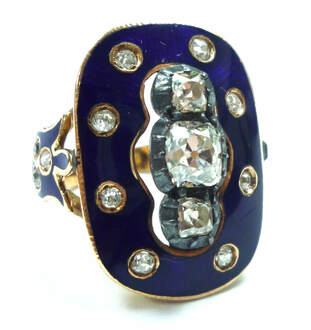Georgian Jewelry Information
Until the mid 1700s, restrictions were placed upon civilians as to what type of jewelry could be worn based upon their income or rank. After these restrictions were lifted, jewelry was no longer exclusive to the aristocracy and became more available to the middle class.
METALS COMMONLY USED
• Gold (14K, 15K, 18K or High Karat Gold)
• Silver
• Silver-Topped Gold
• Pinchbeck (83% Copper, 17% Zinc)
• Steel
• Iron
Georgian jewelry does not have any stamped purity marks or maker's marks.
In 1767, jeweler James Cox invented a technique where gold was soldered to the back of silver jewelry to prevent silver tarnish rubbing off on clothing.
Fer de Berlin jewelry, or Berlin iron jewelry, is very collectible iron jewelry from the Georgian Era. Begining in 1804, Germans donated their jewelry so the precious metals could be used in the war effort. They were given replacement jewelry made from lacquer-coated iron.
METALWORKING TECHNIQUES
• Hand Fabricated
• Repoussé
• Cannetille
Georgian Era jewelry is completely hand fabricated, as it pre-dates machinery that would later be invented to help with jewelry manufacturing.
Prior to the invention of the rolling mill, in 1750, goldsmiths had apprentices who were responsible for hammering blocks of gold, by hand, until they reached the desired thickness of the goldsmith to use for creating jewelry. The rolling mill was able to roll gold and silver into uniform sheets, saving a tremendous amount of labor.
Cannetille is a technique that uses intricate wire work designs that resemble embroidery.
TYPES OF JEWELRY WORN
• Rings
• Bracelets
• Cameos
• Necklaces (Dog Collar, Choker & Riviere)
• Earrings
• Brooches
• Châtelaines
• Matching Parures
Parures were common in the Georgian Era, with jewelry suites containing matching rings, necklaces, brooches, earrings, bracelets, and more. Some parures featured up to 16 matching pieces!
Rings were often navette, oval and rectangular-shaped.
Bracelets were worn in pairs.
Earrings were often fastened by hinged, back-to-front closures.
Châtelaines were a popular, and functional, jewelry item of the Georgian era. Originally designed to fasten to a belt, châtelaines would usually have daily items dangling from multiple chains. Some of these suspended items would include a watch, seal, pocket knife, pencil, perfume, opera glass, mirror, or many other daily household items.
GEMS COMMONLY USED
• Diamond
• Ruby
• Sapphire
• Emerald
• Pearl
• Garnet
• Topaz
• Coral
• Amber
• Chrysoberyl
• Agate
• Shell
• Glass (Paste)
Diamonds and gems were set in crimped collets with closed backs.
Colored gems were backed with foil to enhance their brilliance under candlelight.
Diamonds were fashioned into table cuts, rose cuts and old mine cuts during the Georgian Era.
Briolettes and cabochons were popular cuts for colored gems.
COMMON MOTIFS
• Mourning Jewelry
• Hair Jewelry
• Cameos
• Roman, Greek & Egyptian Motifs
• Grapes
• Laurel Wreaths
• En Tremblant Settings
Greek Keys were very popular motifs, as were laurel wreaths.
Painted miniatures, eye miniatures, and hair jewelry were all used as memorial jewelry during the 1700s-1800s. Actual hair was woven into creative patterns and stored behind a glass window in these jewelry pieces. Sometimes the hair was left exposed, and other times the entire jewelry piece was made from hair.




